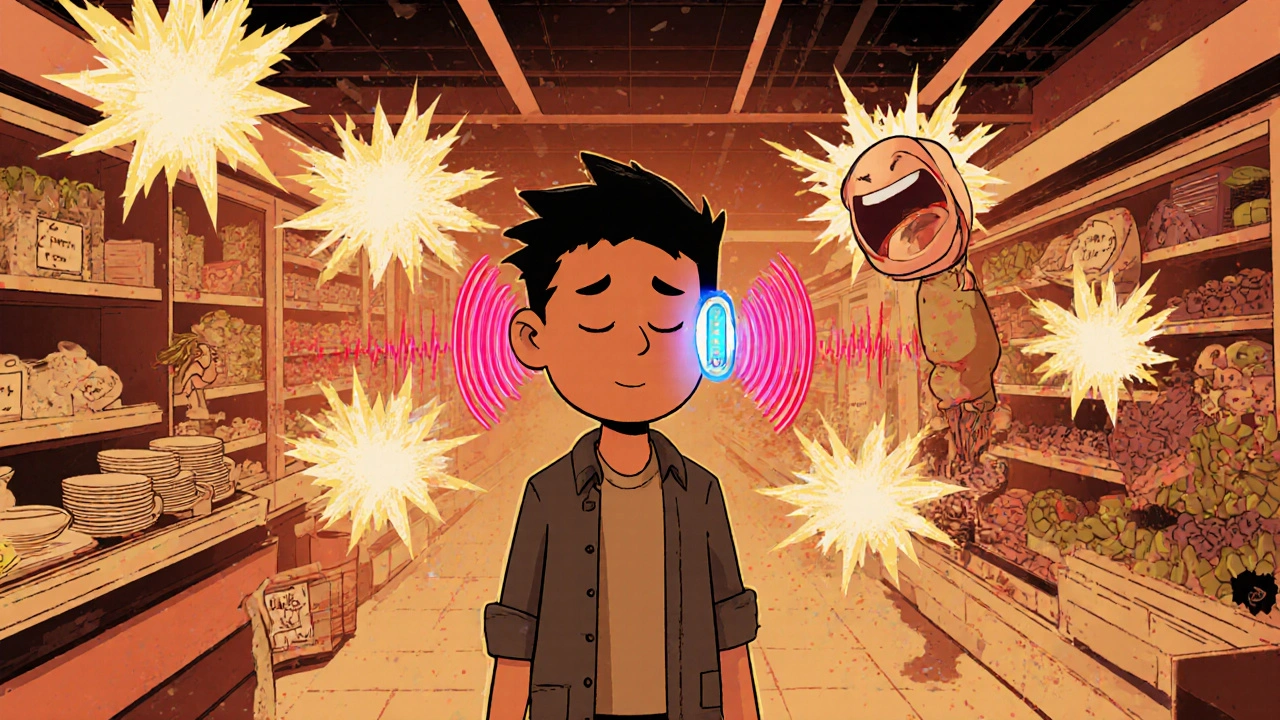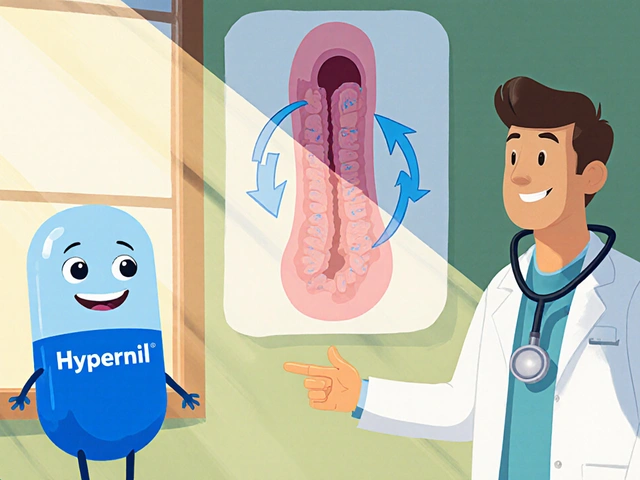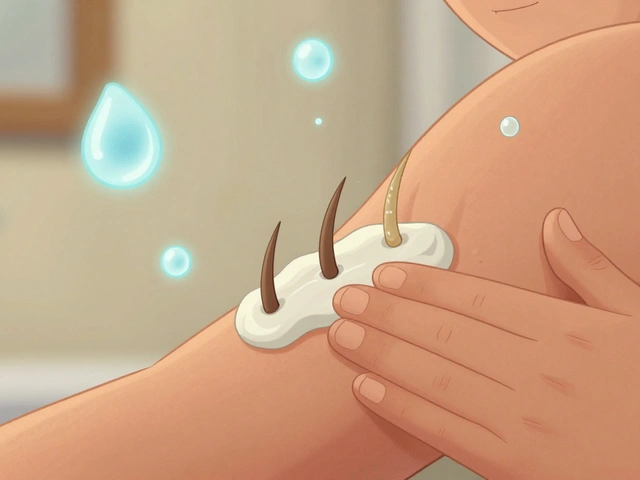Hyperacusis: Understanding Sound Sensitivity and How Desensitization Therapy Works

Imagine walking into a grocery store and the hum of the refrigerator feels like a jackhammer. Or hearing a child laugh in the next room and it triggers a wave of pain in your ears. This isn’t just being sensitive to noise-it’s hyperacusis. It’s a real, measurable condition where everyday sounds become unbearable. Not everyone with hyperacusis has hearing loss. In fact, most people with it hear perfectly fine on a standard hearing test. But their brain interprets sound differently. Loudness doesn’t grow slowly-it spikes. A quiet conversation can feel like shouting. A door closing can feel like a gunshot.
What Exactly Is Hyperacusis?
Hyperacusis is an auditory processing disorder. It’s not a problem with your ears. It’s a problem with how your brain handles sound. The brain’s volume control gets stuck on high. Sounds that most people tune out-like dishes clinking, a dishwasher running, or even typing on a keyboard-trigger discomfort, anxiety, or physical pain. This isn’t psychological. Brain imaging studies show real changes in the auditory cortex and limbic system, the part tied to emotion and fear. About 1 to 2% of people have clinically significant hyperacusis. That’s roughly 17 million Americans. It shows up in all age groups, but it’s more common in people exposed to loud noise-musicians, factory workers, veterans, and people who’ve had acoustic trauma. It can also follow head injuries, Lyme disease, or viral infections like Ramsay Hunt syndrome. The condition affects all frequencies equally, unlike tinnitus, which often targets specific pitches. What makes it worse is that most doctors don’t know how to diagnose it. A standard audiogram won’t catch it. You need a special test called Loudness Discomfort Levels (LDLs). This measures the volume at which sounds become painful. In people with hyperacusis, LDLs can be as low as 50-60 dB-about the level of a normal conversation. For someone without it, discomfort usually starts around 85-90 dB, like a lawnmower.Why Avoiding Sound Makes It Worse
The natural reaction to painful sounds is to protect yourself. Earplugs. Noise-canceling headphones. Quiet rooms. But this avoidance backfires. When your ears are starved of sound, your brain becomes even more sensitive. Studies show that people who avoid noise see their symptoms worsen by 30 to 40% within months. It’s like a muscle that’s never used. If you stop walking because your knee hurts, your leg weakens. The same thing happens with your auditory system. The brain starts overreacting to every little sound because it’s not getting the input it needs to recalibrate. This is why most over-the-counter solutions fail. Hearing aids? They’re designed to amplify sound for people with hearing loss-not to gently retrain a hypersensitive brain. Sound machines? Generic white noise apps don’t offer the precision needed. Even wearing earplugs in a car or at work might seem smart, but it trains your brain to fear sound instead of accepting it.How Desensitization Therapy Actually Works
Desensitization therapy is the only treatment proven to reverse hyperacusis long-term. It’s not a cure. It’s a retraining program. Developed in the 1980s by Dr. Pawel Jastreboff, it’s based on the neurophysiological model: hyperacusis isn’t just about hearing-it’s about fear. The brain links sound with threat, triggering stress hormones and muscle tension. Therapy breaks that link. The process is simple in theory but hard in practice. You expose yourself to low-level, non-threatening sound every day-starting so quiet you might barely hear it. The goal isn’t to make you louder. It’s to make your brain less reactive. Here’s how it works step by step:- You get tested by a trained audiologist to find your exact Loudness Discomfort Levels across frequencies.
- You’re given a small, wearable sound generator-like a hearing aid but programmed to deliver broadband noise (pink or white noise) at 10-15 dB below your discomfort level.
- You wear it for 4 to 8 hours a day, while doing normal activities: reading, cooking, walking.
- Every week, the volume increases by 1 to 2 dB. No more. No less.
- After 6 to 12 months, you slowly reintroduce real-world sounds: cafes, traffic, family gatherings.

Success Rates and Real Results
Clinical trials show 60 to 80% of people who complete the full program see major improvement. That means they can go to restaurants without earplugs, watch TV at normal volume, or sit in a car without flinching. One Reddit user shared: “After 11 months of daily sound therapy starting at barely audible levels, I can now tolerate grocery stores and restaurants without earplugs-life-changing.” Success depends on three things:- Starting at the right volume (too high = setback)
- Doing it every single day (missing 2 days a week cuts success by half)
- Working with a specialist who understands the protocol
What Doesn’t Work
There are a lot of scams out there. Some clinics push expensive hearing aids for hyperacusis. But standard hearing aids amplify sound too much and lack the low-level, steady output needed for retraining. They cost $1,500 to $6,000 per ear. A proper sound generator costs $200 to $800. Medications? Antidepressants or anti-anxiety drugs might help with the stress, but they don’t fix the sound sensitivity. Studies show only 25 to 35% symptom reduction with meds alone. Cognitive Behavioral Therapy (CBT) helps with anxiety, but alone, it doesn’t retrain the brain’s auditory pathways. The best results come from combining CBT with sound therapy-35% better outcomes than sound therapy alone. And don’t fall for “miracle” apps or YouTube sound therapy playlists. Most aren’t calibrated. They play random noise at random volumes. Real therapy uses precise, clinically tested protocols. The American Tinnitus Association gives desensitization therapy a “strong recommendation” with Grade A evidence-based on 12 randomized controlled trials.Who It Works For-and Who It Doesn’t
Desensitization therapy works best for people with noise-induced hyperacusis or post-traumatic cases. Success rates hit 75 to 85% in these groups. It also helps people with tinnitus who developed sound sensitivity alongside it. But it’s less effective for those with neurological conditions like superior canal dehiscence, Ramsay Hunt syndrome, or severe migraines. In these cases, the problem is structural or chemical, not just neural. About 40 to 50% of these patients don’t respond. People with misophonia-where specific sounds like chewing or tapping trigger rage-also need modified protocols. The therapy still helps, but it’s slower and requires more psychological support.
What You Need to Get Started
If you think you have hyperacusis, don’t wait. The longer you avoid sound, the harder it gets to fix. First, find an audiologist who specializes in hyperacusis. Not all do. Ask if they use the Jastreboff protocol or have trained in Tinnitus Retraining Therapy (TRT). Check with the American Academy of Audiology or Hyperacusis Research Limited for referrals. You’ll need:- A full audiological evaluation, including LDL testing
- A programmable sound generator (not a hearing aid)
- A sound level meter app (like Decibel X) to track environmental noise
- A journal to track daily exposure and symptoms
The Future of Treatment
New tech is making therapy more accessible. In 2023, the FDA cleared the Lenire device, which combines sound with mild electrical stimulation to the tongue-showing 67% improvement in trials. Telehealth platforms are growing fast, with 40% more virtual therapy options each year since 2020. MIT is testing AI-driven sound therapy that adapts in real time based on your heart rate and stress levels. Early results show 23% faster progress. But the biggest barrier isn’t technology-it’s access. Only 22% of U.S. audiology clinics offer formal hyperacusis programs. And only 35% of audiologists are certified in the therapy. That’s changing, slowly. The Hyperacusis Research Foundation predicts half of all affected people will get proper treatment by 2030. Right now, only 15% do.Final Thoughts
Hyperacusis doesn’t have to be a life sentence. It’s not a sign of weakness. It’s a neurological condition that can be reversed-with time, patience, and the right approach. The therapy is demanding. Progress is slow. But for those who stick with it, the reward is real: the ability to live without fear of sound. If you’re reading this because you’re tired of hiding from the world, know this: you’re not alone. Thousands have walked this path. And many have come out the other side-not just tolerating sound, but living with it again.Can hyperacusis go away on its own?
No, hyperacusis rarely resolves without intervention. Avoiding sound may seem like relief, but it often makes the condition worse over time. Without targeted therapy, the brain’s sensitivity to sound typically stays the same or increases. Professional treatment is necessary to retrain the auditory system.
Is hyperacusis the same as tinnitus?
No. Tinnitus is the perception of ringing or noise in the ears with no external source. Hyperacusis is an increased sensitivity to actual external sounds. However, the two often occur together-about 40% of people with tinnitus also have hyperacusis. The same therapy can help both, since they involve similar brain pathways.
Do earplugs help with hyperacusis?
Earplugs offer short-term comfort but make long-term recovery harder. Overuse trains your brain to see sound as dangerous, increasing sensitivity. If you must use them, limit them to truly harmful noise levels-like concerts or power tools. Never wear them for normal daily environments like traffic or conversation.
How long does desensitization therapy take?
Most people need 9 to 18 months of daily therapy to see lasting results. The average is about 12.7 months. Progress is slow at first-many don’t notice changes until month 6 or 7. The key is consistency. Skipping days or rushing the process reduces success rates significantly.
Can children have hyperacusis?
Yes. Children can develop hyperacusis after ear infections, head injuries, or exposure to loud noise. It’s often overlooked because kids may not describe symptoms clearly. Signs include covering ears, crying at normal sounds, or avoiding noisy places. Therapy can be adapted for children with parental support and modified sound exposure schedules.
Is hyperacusis covered by insurance?
Insurance coverage varies. Audiological evaluations and therapy sessions may be covered under hearing health benefits, but sound generators are often considered durable medical equipment and require pre-authorization. CBT sessions may be covered under mental health benefits. Always check with your provider and ask for a diagnostic code: ICD-10 H93.25 (hyperacusis).
What if the therapy doesn’t work for me?
If you’ve followed the protocol correctly for 12+ months with no improvement, there may be an underlying neurological or structural issue. You’ll need further testing-like an MRI to rule out superior canal dehiscence or vestibular disorders. Some cases require a multidisciplinary approach involving neurologists or ENT specialists. Don’t give up-work with your audiologist to adjust the plan or explore alternative therapies.






Rusty Thomas
November 20, 2025 AT 03:17Okay but have you ever tried listening to your own damn breathing? It’s like a chainsaw in a library. I used to wear earplugs to bed. Now I sleep with a white noise machine that sounds like a dying fax machine. And guess what? It’s the only thing keeping me from screaming into a pillow. 🤯
Lemmy Coco
November 21, 2025 AT 22:04i was diagnoised with this last year after a bad ear infection… i didnt know it was a thing. thought i was just weird. started the sound therapy 6 months ago. its slow. like really slow. but last week i sat in a coffee shop and didnt flinch. i cried. lol
rob lafata
November 22, 2025 AT 08:26Oh wow, another one of those ‘your brain is broken’ stories. Let me guess-you’re also allergic to sunlight and think Wi-Fi is poisoning your soul? You avoid sound because you’re scared, not because your auditory cortex is ‘stuck.’ This isn’t medicine, it’s spiritual warfare with a side of audiologist hustle. You’re being exploited. Buy a $200 sound generator? Ha. Go meditate. Or better yet-stop being so fragile.
Matthew McCraney
November 22, 2025 AT 11:22They don’t want you to know this but hyperacusis is caused by 5G towers and CDC mind control. They’re testing sound weapons on civilians under the guise of ‘therapy.’ I know a guy who works at the FDA-he says the Lenire device is just a distraction so we don’t notice the microchips in the earpieces. You think you’re getting better? You’re being programmed. Check your EMF readings. And stop wearing those ‘sound generators’-they’re listening devices. 🚨
serge jane
November 23, 2025 AT 23:41There’s something deeply human about the way we fear what we cannot control. Sound is everywhere, unavoidable, indifferent. We build walls, we plug our ears, we silence the world-but the world doesn’t care. The therapy doesn’t fix your ears. It teaches you to sit with discomfort without flinching. It’s not about volume. It’s about presence. And maybe that’s the real cure-learning to be in a world that doesn’t whisper for you. You don’t need a device. You need a willingness to be vulnerable. And that’s harder than any decibel.
Nick Naylor
November 24, 2025 AT 04:51Brianna Groleau
November 25, 2025 AT 15:40I’m from a small town in Texas where no one had ever heard of hyperacusis. My daughter was 7 and started screaming every time the microwave beeped. We thought she was being dramatic. Turns out, her brain was screaming louder than she was. We found a specialist in Dallas. Took 14 months. Now she sings in the shower. I cried when I heard her. Not because it was perfect-but because she wasn’t afraid anymore. You’re not broken. You’re just unheard.
Sarah Swiatek
November 25, 2025 AT 19:39Oh honey. You think you’re the first person to suffer from this? I’ve been doing this therapy since 2018. I started at 45 dB-barely louder than a whisper. My dog used to bark louder than my sound generator. People thought I was crazy wearing those little ear things everywhere. But I kept going. And now? I can sit through a family reunion without wanting to stab my ears with a fork. It’s not magic. It’s math. And patience. And not listening to the internet trolls who think you’re ‘just anxious.’ You’re not. You’re just a brain that got glitched. And you’re fixing it. Slowly. But you’re fixing it.
Dave Wooldridge
November 26, 2025 AT 17:23They’re lying. This is all part of the Great Sound Suppression Agenda. They want us to be quiet so they can control the narrative. The ‘sound generators’ are actually broadcasting subliminal messages to make you compliant. The 60-80% success rate? Fabricated. The FDA cleared Lenire because they’re paid off by Big Audiology. I’ve seen the documents. I’ve seen the emails. Don’t trust the audiologist. Trust your gut. And turn off your Wi-Fi. That’s what really makes it worse.
Rebecca Cosenza
November 27, 2025 AT 00:38I tried earplugs for a month. Made it worse. Started therapy. Still hate loud noises. But now I can eat in a restaurant without panic. Progress isn’t pretty. But it’s real. 🙏
swatantra kumar
November 28, 2025 AT 01:35Bro I’m from India and we don’t even have 1 audiologist who knows this in my city. I found a YouTube video in Hindi and made my own sound generator from an old Bluetooth speaker and a pink noise app. Been doing it 8 months. My mom thinks I’m crazy. But last week I watched a cricket match on TV at normal volume. No headphones. No flinching. 🙌 Maybe the world is slowly waking up. Or maybe I’m just lucky. Either way-keep going.
Cinkoon Marketing
November 28, 2025 AT 11:54So… like… if your brain is ‘stuck on high,’ why don’t we just… reset it? Like a factory reset? I feel like this is just a software bug. Maybe you just need to uninstall the fear app and reinstall the calm one. Or maybe it’s a firmware update? I dunno. I’m just a marketer but I think you guys are overcomplicating it. Also, have you tried CBD? I heard it helps with everything.
robert cardy solano
November 30, 2025 AT 05:01My neighbor has this. Wears headphones 24/7. Won’t talk to anyone. I used to think he was just weird. Now I get it. Last week he walked past my house without his headphones. Just… stood there. Looked at the birds. Didn’t cover his ears. Just… listened. I didn’t say anything. Didn’t need to. That was the moment he won. Not when he got the device. Not when he hit 75 dB. When he stopped fighting it.
Pawan Jamwal
December 1, 2025 AT 06:21India has 1.4 billion people and not one government hospital offers this therapy. You think this is a ‘Western problem’? No. It’s a human problem. And the rich get treatment. The poor get silence. I’ve seen kids in slums cover their ears when a bus passes. No one helps them. You talk about science? Fine. But where’s the equity? Where’s the access? Stop treating this like a personal journey. It’s a public health crisis.
Bill Camp
December 1, 2025 AT 22:32My cousin is a Marine. Got hyperacusis after an IED blast. Went through the full 14-month therapy. Now he’s back to coaching his kid’s baseball team. He says the worst part wasn’t the sound. It was the loneliness. No one believed him. No one knew what he was going through. This post? It’s the first time he felt seen. So… thanks. For writing this. Even if you’re not my cousin. You’re still helping.